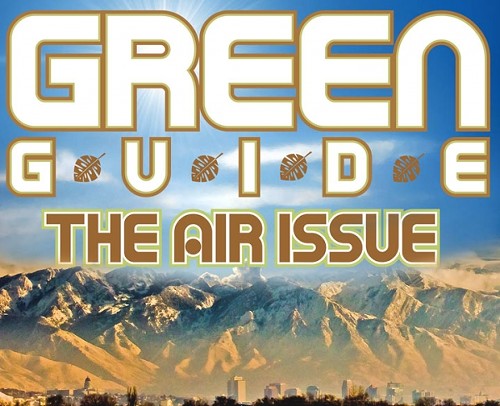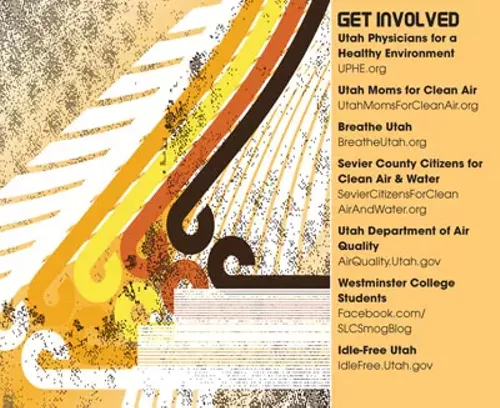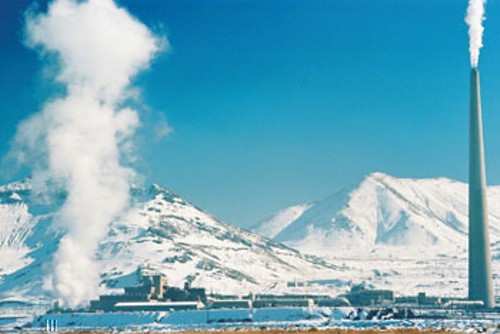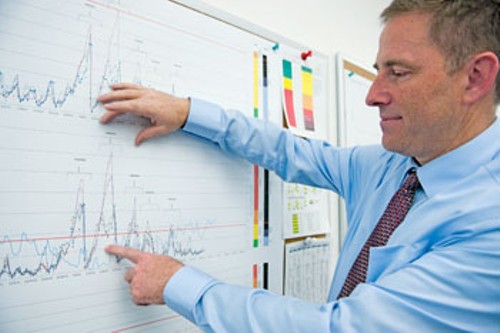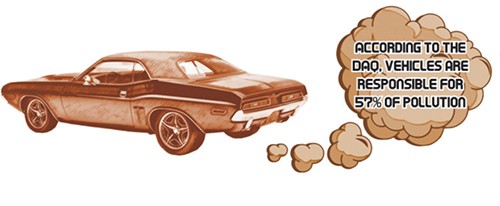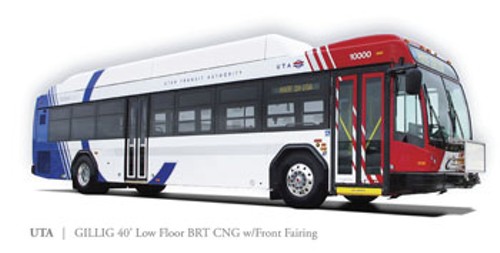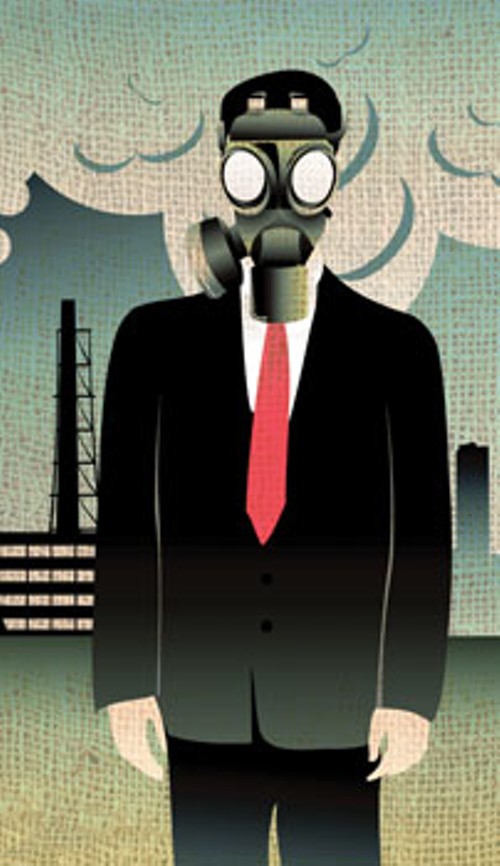Green Guide 2013: The Air Issue
Lawmakers do little to clean up chunky air
By Stephen Dark @stephenpdark
The Air Issue
Lawmakers fluff their wings but do little to clean up Utah’s chunky air.
January 2013 catapulted Utah onto the world stage—for all the wrong reasons. An oppressive smog extended from Provo, across Salt Lake City, and north to Logan. Only driving up to Park City afforded escape.
You could taste the air. You could see it, a brownish, thick haze. Throughout January 2013, Salt Lake City’s sky looked like something out of a 1950s sci-fi movie. All it required was a mad scientist screaming, “Don’t breathe the air!”
The American Lung Association ranked the Salt Lake City-Ogden metro area, Logan and Provo as the seventh, eighth and 11th most polluted cities, respectively, for PM2.5—the smallest particulate matter in the air, smaller than the diameter of a human hair, tiny enough to lodge in the lungs of those who breathe the air. In January 2013, Utah’s air hit 90 micrograms of particles per cubic meter of air in one-hour concentrations, close to three times the federally designated safe level of 35 micrograms of particles per cubic meter.
In a state that prides itself on the glories of its outdoor life, doctors were advising residents that being outdoors on a day with heavy pollution—a red-air day—was the equivalent of smoking a pack of cigarettes a day. The Utah Division of Air Quality (DAQ) warned citizens to stay indoors during red-air days, and schoolchildren weren’t allowed outdoors during recess. The DAQ estimates that 1 in 3 Utahns experiences some type of respiratory problem during high-pollution periods.
The smog finally dissipated in late January, the day before the 2013 legislative session began. Multiple activist groups rallied at the Capitol, demanding action during the session. At the same time, the Utah Governor’s Office and the DAQ laid the blame for much of the smog on the citizens, claiming vehicle tailpipes were responsible for 57 percent of the pollution. Air activists scoffed and accused the state of obfuscating a health emergency with numbers.
So, who or what is responsible for our dirty air, and what can we do about it?
The answer, if we are to look at lawmakers’ efforts, is not much. By the end of the session, little of substance, according to activists, had come forth.
The Democrats offered several bills. Rep. Joel Briscoe, D-Salt Lake City, proposed giving out mass-transit passes for two months of the year “to get you out of your car and getting to work on a bus or TRAX.” But he couldn’t get his bill out of the rules committee. UTA estimated the cost of Briscoe’s proposal at $9 million. “As soon as you start hitting cost, it engenders opposition,” Briscoe says.
Utah Physicians for a Healthy Environment’s president, Brian Moench, says Utah needs to address infrastructure for mass transit that “is broad enough that it becomes a realistic option for people.” He tried to take the bus to the hospital where he works, but found “I could actually get to and from work faster by running.” UTA’s bus service is “not convenient enough, too expensive, and has to be supported by public funds.”
Rep. Patrice Arent, D-Millcreek, introduced House Bill 168, which required state agencies to come up with a voluntary plan to reduce emissions from state fleets. The bill survived the legislative session, but drew little respect from activists, who felt it lacked teeth.
The Legislature passed three clean-air-related bills. The most controversial was Senate Bill 275, sponsored by Sen. Stuart Adams, R-Layton, which proposed additional infrastructure for state and private vehicles to be fuelled by compressed natural gas (CNG). Some saw it as a money-grab by the Utah Transit Authority, effectively getting Questar’s customers to pay for refueling and maintenance infrastructure through a utility rate hike. The bill made it through the session, but many questions linger about both its intent and impact on utility rates and pollution.
Sara Baldwin is a senior policy and regulatory associate for nonprofit Utah Clean Energy who says that discussions about air quality need to move beyond party lines. “We really need to start to get serious about what we can get done. At the end of the day, we are all breathing this air. We all live here, work here and want to play here, and our quality of life is declining every single day we have a red-quality air day. Our hope is to get past partisan rhetoric and move toward solutions.”
If the public saw little progress made to address the inversion, nonprofits like Utah Physicians for a Healthy Environment and Utah Moms for Clean Air nevertheless benefited from higher profiles as the clamor for solutions grew louder during the height of the inversion. Rep. Patrice Arent says, “They have been effective,” particularly in helping people understand the issues, “getting people involved, keeping the pressure on.”
Amid all the rhetoric and number-juggling, Moench argues the bottom line is people’s lives. He argues the state’s support for businesses at the expense of air quality is killing its citizenry. His organization estimates that 1,200 to 2,000 Utahns die prematurely each year from pollution-related illnesses.
“Governor Herbert is determined the economic future of the state is fossil fuels,” and that is something the Legislature agrees with, Moench says. Coupled with Utah’s traditional legislative disdain for environmentalism, the fight for clean air is an uphill one. “This shouldn’t be a political battle because it’s public-health issues,” Moench says. “But you’re labeled ‘political’ when you speak out forcefully for policy.”
The air has forced some Utahns to leave a state they love, while others stay but struggle with respiratory issues and other medical complications. Wherever the blame lies, what is undeniable is, as Briscoe says, “every person on the Wasatch Front is living a slightly shorter life because they’re breathing this air.”
The Blame Game
Who or what is the source of the toxic air along the
Wasatch Front? It’s hard to say when everyone points at another.
Cherice Udell, of Utah Moms for Clean Air, thought the fight for air quality in Utah had turned a corner.
During specific days of January 2013, Logan, Brigham City and Provo were ranked by the Environmental Protection Agency as having the most unhealthy air in the nation. The worst inversion in recent memory had galvanized public opinion against legislative indifference to the issue.
Marjorie McCloy gathered a petition of 8,500 signatures in less than 10 days, Udell says, to ask Utah Gov. Gary Herbert to act against polluters and promote public transportation. Environmental and sustainability studies student Carl Ingwell was so angered by “the difference between public opinion and public policy” when it came to air quality that he set up a Facebook page to get friends “to write the governor a letter and say, ‘Hey, we’re sick of this, let’s do something,’” he says. To his amazement, 1,500 people quickly signed up.
So, when a reporter approached Udell on the steps of the Utah Capitol with a pie chart from the Utah Division of Air Quality (DAQ), which, among other things, monitors what’s in the air, and said, “Industry is only making 11 percent of the inversion, don’t you think cars are a major part of the problem?” she was dumbfounded. “I was incensed by it—really, really angry about such misleading material.”
The pie chart is titled “The Air We All Breathe,” and shows that vehicles are responsible for 57 percent of air pollution. According to the chart, gases from “area sources,” such as houses, small businesses and buildings, account for 32 percent, and industry—including power plants, oil and gas refineries, and mining—no more than 11 percent.
“Disingenuous at best, political propaganda at worst,” Udell says. “How can we tackle the problem when they are pointing at the individual citizen driving his car, when it’s much more diverse than that, when industry is responsible for so much more than that?”
DAQ director Bryce Bird disagrees. It’s all a question of perspective, he says. “How you slice the pie depends on the answer you get.”
While clean-air activists have regularly peppered The Salt Lake Tribune with editorials and comments about the devastating impact the air quality has on Utahns’ lives, Bird argues that it’s the DAQ’s increasing effectiveness that has spurred much of the debate about clean air. DAQ has upgraded its monitoring efforts, he says, to provide “real time” readings of PM2.5 and ozone concentrations in various locations across the valley. “In some respects, the public perception and outcry reflects our efforts to get information out there,” he says.
The pie chart, Bird says, looks at a five-county airshed stretching from the southern end of Utah County to Cache County, to show “what’s being emitted on a typical winter day on the valley floors.” Since Utah County and Cache County have little in the way of an industrial base, automobiles are responsible for the lion’s share of the air pollution in those areas.
In Salt Lake County, according to the DAQ’s figures for 2011, 9.3 percent of the total monitored pollution, including PM2.5, carbon monoxide and mono-nitrogen oxides, comes from “point sources”: stationary, commercial and industrial sources that emit more than 100 tons of monitored pollutants a year.
According to the DAQ, Kennecott Copper Mine, a mining, smelter and refining operation, is responsible for 49 percent of Salt Lake County’s pollution from point sources. Kennecott spokesman Kyle Bennett says Kennecott, which is owned by United Kingdom-based mining corporation Rio Tinto, has long been committed to finding “action-orientated solutions” to reducing its emissions, whether in the form of a billion-dollar smelter, “which continues to be one of the cleanest and most modern smelters in the world,” by not operating its own power plant in the winter months, by distributing “a limited number of transit passes on red-air days” or supporting idling-reduction across its companies.
While on X96.3 FM’s morning show Radio From Hell, student activist Ingwell asked Bird to break down the sources of pollution for Salt Lake City. Bird told him that over the course of a year, responsibility breaks down into one-third industrial, one-third vehicles and one-third sources such as houses and businesses.
The United States Environmental Protection Agency (EPA) has established National Ambient Air Quality Standards for air pollutants, including PM2.5. If the air quality in a geographic area does not meet standards, the state must develop comprehensive plans to reduce pollutant concentrations to a safe level.
The Utah DAQ’s submission to the Environmental Protection Agency to bring five counties currently above the safe level for PM2.5 into line states that “stationary sources […] represent at most about 20 percent of the emissions contributing to excessive PM2.5 concentrations during winter,” further complicating the pollution picture.
Part of the problem, says Brian Moench of the nonprofit Utah Physicians for a Healthy Environment, is that the focus on the winter inversion leads to the perception that this is an issue that only arises in the dead of winter and a week or so in July, when wildfires contribute heavily to haze. So, he says, when industry seeks new permits to expand, “that doesn’t seem such an egregious issue.”
He argues that the DAQ—which regulates and monitors air quality, issues permits for new and modified pollution sources, and also pursues compliance—is chronically underfunded.
DAQ has three sources of funding, with equal parts from federal grants, emission fees it charges businesses, and the General Fund. The Legislature cut funding for the DAQ by 20 percent between 2008 and 2010. That meant eliminating staff positions, which in turn led to a slowdown in permit-processing.
Moench says that in the 2013 session, one bill “emasculated an already weak Air Quality board,” removing a physician and a professional engineer, neither connected to industry, and replaced them with one position: a physician, professional engineer or scientist not with industry. The bill also removed an environmentalist, reducing the board to nine members. When his nonprofit and others protested Rio Tinto’s application to expand several years ago, they took their case to the Air Quality board “and lost by one vote,” he says.
Bottom line, Moench says, DAQ is hobbled, caught between pro-business legislators and a governor “who has a real love affair with fossil fuels and doesn’t want to educate himself about this being a public-health concern.” Herbert, he argues, sees the state’s future as built on fossil fuels. The agency’s lack of effective policing of industry reflects “a culture of capitulation to business in Utah which stems from the Legislature and the Governor’s Office.”
Bird says his agency’s ultimate focus is meeting federal regulatory requirements and, when Utah is not meeting the feds’ health-based standards, “bringing it back as quickly as possible.”
In 2011, Moench and Udell’s nonprofits joined forces with WildEarth Guardians, the Sierra Club and Western Resource Advocates to use the Clean Air Act to try to force Kennecott to reduce its emissions, filing a lawsuit in federal court against the company. The lawsuit says that Kennecott has expanded its operations from moving 150 million tons of material annually to as much as almost 200 million tons a year.
The Air Quality board and DAQ had approved these increases—Kennecott argued that it has larger haulage trucks so the higher levels of dust emissions from the moving of material was offset by the reduced volume of vehicle emissions—but Joro Walker of the Western Resource Advocates says that in 1994, the original State Implementation Plan set a federally enforceable cap of 150 million tons, which Kennecott had since violated. “I really think the issue is when we need to reduce emissions, it’s bad policy to allow industries to increase their emissions.”
Kennecott spokesman Bennett says his company is “very confident in our position. We comply with all laws and regulations regarding air quality and emissions.” He adds that the mine has been and “continues to be in constant compliance with permits established for us.”
Kennecott, however, is only one source of industrial emissions that worries Moench and other activists. In 2009, three zones in Utah—Salt Lake City, Provo and Cache Valley—were declared by the federal government to be in “nonattainment” of the safe levels of PM2.5. By September 2012, when DAQ submitted its provisional plans to bring those areas into attainment of the national health standards—the deadline for the final draft was December 2012, which DAQ missed—it concluded it would not be able to do so until 2020.
“This means that by the agency’s own calculations, a child born today will be exposed to air pollution that jeopardizes her health in significant and long-lasting ways for the first eight years of her life,” wrote Western Resource Advocates’ Walker in a Nov. 1, 2012, letter to DAQ.
Walker takes a hard line with DAQ “failing to undertake a thorough and robust review” of controls it was aware of but has not as yet implemented. “Rather than exhibiting a true concern for the well-being of the people who live across the Wasatch Front, DAQ has merely postponed hard decisions and rigorous action and has condemned the children and the elderly of Utah to shortened lives, reduced quality of life and a myriad of adverse health conditions caused by PM2.5 air pollution.”
The EPA sent the DAQ detailed and extensive criticism on its proposals, which the DAQ is now working to address. But Moench finds it disturbing that the DAQ had industrial polluters prepare their own proposals, based on cost-effectiveness, for what they would do to reduce emissions.
“It was really an eye-opener going through the EPA’s comments” on the State Improvement Plan, Moench says. “It identified so many areas where Kennecott and the oil refineries could do more and where they were not being asked. It was basically a sham. They were allowing industries to identify themselves what they thought was cost-effective and, by doing that, eliminating most of what they could do to reduce emissions.”
Bird blames the issue on “a lack of communication” of the strengths and weaknesses of evaluations of emission-reduction proposals and says his agency has hired an independent engineering consulting firm to help the DAQ estimate costs for the larger projects that industry needs to look at to bring down pollution.
Still, Bird anticipates that, at best, industrial pollution can be cut by no more than 5 percent. No one wants to regulate jobs out of the state, Bird says. “Economic development is also an indicator of good health. People have good insurance, they purchase cleaner cars.”
The largest source of future reductions will come from transportation and area sources, Bird predicts. He also cites 8,000 tons annually coming from consumer products, such as solvents, perfumes and aerosols used to kill wasps or clean ovens, all of which have a greener alternative that Utah could import. “Everything is a drop, but once you get up to a few thousand drops, you make a big difference. No strategy is too small,” he says. “We’ll take small improvements from anyone.”
Hot Air
Legislators saw SB275 as a means to improve Utah’s air. Others saw another UTA subsidy.
By the end of the 2013 legislative session, Sen. Stuart Adams, R-Layton, declared himself content with the progress that Utah’s politicians had made on the clean-air issue. In a March 26 daily update on UtahPolicy.com, he cited three bills passed by legislators. “Some say we did nothing to clean up the air this session. They are wrong. Thanks for paying attention.”
Advocates, though, along with natural-gas utility Questar, did pay attention to one of the three bills, Senate Bill 275, sponsored by Adams. When the bill appeared late in the session, what caught the eye of consumer advocate Claire Geddes was that rather than a clean-air bill, “it was nothing more than [Utah Transit Authority] looking for money.”
But Rep. Greg Hughes, R-Draper, Utah Transit Authority’s chairman, says his passion for compressed natural gas (CNG) came after Questar urged him three years ago to consider converting UTA’s fleet of 350 to 400 buses to CNG.
The bill, Adams wrote in Utah Policy Daily, “creates opportunities for Utah to expand natural-gas infrastructure and increase the use of compressed natural gas.” The most controversial part of the bill was the funding mechanism, which involved a rate hike for all Questar consumers that would provide up to $5 million in the first year and, potentially, unlimited amounts in the next four years to pay for CNG fueling and CNG-fleet maintenance infrastructure, the open-ended provision being repealed in 2018, according to the bill’s final version.
Questar has quietly funded, through adding a legislatively approved few cents to its rates over several decades, an expansion of CNG stations. Utah now has 88, the nation’s highest number of CNG stations per capita. SB275 sought to effectively have ratepayers subsidize “the construction, operation, and maintenance of natural gas fueling stations […] for use by the state, political subdivisions of the state, and the public,” according to the bill.
Hughes says that “some places in the country, the social value [of such projects] outweighs the costs,” but not in Utah. “We are a frugal state. If it doesn’t make money, it doesn’t make sense.” But when Utah endured what Hughes calls “the soupiest inversion” in recent history, and tailpipe emissions were identified by the Governor’s Office as the main culprit, an opportunity emerged, he says, for the Legislature “to take thousands of government fleet vehicles and tackle directly the pollution impacting the valley.”
Crossroads Urban Center’s Tim Funk, however, saw the bill establishing “a way for UTA to have an unlimited and unregulated access to another funding source that allows them to expand their bus fleet to convert existing buses or purchase new ones running on natural gas.”
Hughes says the rate hike, which he put at 8 cents a month, 96 cents a year, was marginal. “The impact [to ratepayers] we’re talking about is decimal dust,” he says. “I could make more money than that with a piece of cardboard at an off-ramp begging.”
Hughes presented an amendment to the House, proposing it remove the $5 million cap. The amendment ultimately failed. Questar’s spokesman Chad Jones says that when the discussion became about taking off the cap, “at that point, we pulled out. We were not interested in having our customers responsible for whatever they come up with.”
UTA has ordered 24 CNG buses, a far cry from what its chairman had envisioned. The first 10 buses will be delivered in June 2013.
“The bill ended up one of the greatest frustrations I’ve experienced in the Legislature,” Hughes says. “The political climate was there to launch a grand plan, and I think we went small.”
Every Breath You Take
Utah’s air sends some to the hospital
and others packing.
War stories, it seems, extend to the inversion.
Iraq veteran Andy Figorski, who works at the Veterans Administration, was having a hard time breathing this January. “I thought I was having a heart attack,” he says. He went to the VA’s ER, and they ran some tests. “It turned out to be lung inflammation due to the inversion. Don’t you love this place?”
The inversion hit close to home for Rep. Joel Briscoe, D-Salt Lake City. His children were having a hard time breathing, and his wife, who has asthma, told him, “every time she took a breath, it was like a 10-pound weight as she pushed her chest wall out.”
City Weekly asked readers to write in with any health concerns they had related to the inversion. Alexander Woodruff e-mailed that he had “respiratory issues through the winter months as well as multiple occurrences of illness,” which stopped him from enjoying outdoor activities. “I shouldn’t have to deal with the news telling me to try and not breathe outside if at all possible!”
Duane Vigil, a lifelong Utah resident, commutes to work by bike. In mid-March, he developed a respiratory infection that he believes came from the inversion. He tried fruit, Vitamin C boosters, teas—nothing worked. “The only thing that worked for me was a mask.”
Liz Mallen has 5-year-old twins. Shortly after their birth, both contracted a respiratory virus that, she believes, has made them sensitive to inversions. “As soon as the inversion gets bad … [one of my son’s] cough flares.” When the children went back to school, “all it took was one day back in the muck, and he was home for a week.”
Air pollution is not just an issue for lung-disease sufferers, Utah Physicians for a Healthy Environment President Brian Moench says. “It causes an unimaginable array of medical problems, lung disease, cancers, it interferes with the blood flow through the placenta and development of the embryo.” He says he knows that fetal demise occurs at higher rates during bad air periods. “I have seen a truckload of these during the inversion.”
While anecdotal, such stories perhaps help explain the Facebook group “I have moved or am moving out of Utah because the air quality is so crappy,” which has 200 members. Former residents and those contemplating moving posted in detail about their searches for out-of-state jobs, driven out by Utah’s bad air.
Jamie Leavitt “had to move out of Utah because I developed asthma, allergies, and persistent migraines all due to the poor air quality,” she writes. The high level of pollution “made life unbearable for me.” She moved to Los Angeles, near the beach, and found a life where none of the medical issues that had haunted her in Utah were present. “I miss my family, and the Wasatch front is so beautiful, but the massive amount of pollution meant a move so my dog and I could breathe (and sleep) better.”
Businesses also see the impact on recruitment of Salt Lake City’s infamous bad air. Several politicians recalled how Overstock.com’s president, Jonathan Johnson, testified before a legislative task force about bringing potential employees to the valley, only for them to witness the smog and turn down job offers.
In the face of so much activism, so much concern, Moench remains “more hopeful now than I’ve been since we started this,” he says. “Because the winter was bad enough, it appeared on the radar of more people and more key people than it ever has before. If we can maintain that momentum, I think things can change.”
Speaking of...
-
Best Of Utah 2014: Goods & Services
Best Antiques/Collectables Now & Again Since bursting onto the retro scene in 2009, this downtown shop has racked up loyal fans who count on the keen eye of owner Michael Sanders to find the choicest mid-century furniture and fun
- Mar 26, 2014
-
CWMA 2014
City Weekly Music Awards: Utah's biggest Local Music event
- Feb 12, 2014
-
Wine Wednesday: Epic X96 Beer Brunch
- Oct 24, 2012
- More »
More by Stephen Dark
-
Call it a Comeback
Long mired in economic depression, Midvale’s Main Street dusts off its small-town charm.
- Sep 20, 2017
-
Love Letters
Correspondence between a young woman at the Topaz internment camp and her beloved sheds light on Trump's America.
- Sep 6, 2017
-
Triggered
Veterans Affairs exists to help vets. So why did the Salt Lake VA appoint an anti-veteran chief?
- Aug 30, 2017
- More »


